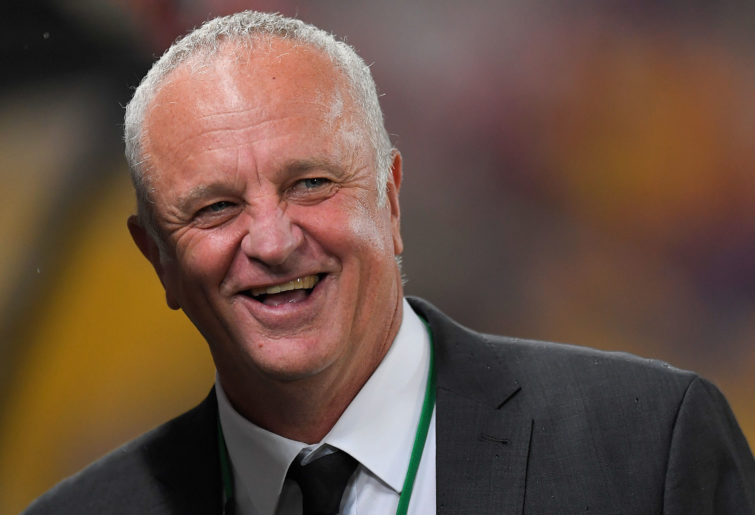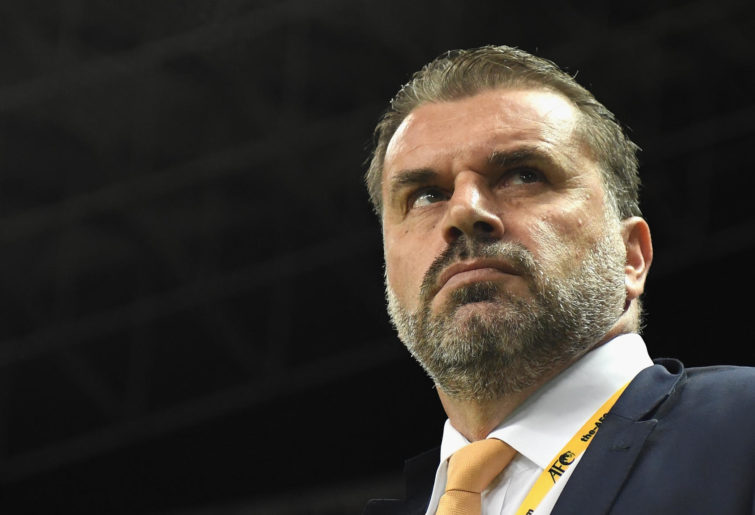Thousands of cumulative hours are dedicated to the national conversation about the standard of footballer Australia is producing and how it compares to the standards of the products from other football-playing nations.
Petabytes of data have been committed to the cause of analysing where our players excel and fall short, what part of the country produces the most talented players and why and which skills should be emphasised and which habits to be pruned back.
A conversation about the standard of our local managers is just as relevant to Australia’s future footballing prospects, and yet it feels as though far less time and energy has been burnt up conducting it.
Seeing Aaron Mooy score twice for Huddersfield last weekend was a very welcome sight, a sudden and desperately needed burst of offensive incision for both the player and his team.
It did enough to wash down the acrid taste of the news that had come out a week or two earlier that Harry Kewell had been sacked by Notts County after just 14 games. As much as this wasn’t exactly surprising – by all accounts the team had been poor under Kewell, and I don’t think, of all our ex-Socceroos, anyone had Harry picked as the next great football mind – it was still disappointing.
So for the purposes of this discussion I’d like to bring up that acrid taste again, a reflux to inspect and inspire a larger discussion.

(Albert Perez/Getty Images)
Kewell had been the only Australian manager in the top three English leagues. It’s not really a surprise; Australian managers, certainly of late, do not travel well.
Just looking in Asia, the place that would seem a logical first step for an Australian looking to manage abroad, in the Japanese, Korean, Chinese, Thai, Indonesian, Hong Kong, Singaporean and Malaysian top flights there are two Australian managers working currently. Really, the shining light for Australian managers working at the elite level of their field is Joe Montemurro, head coach of Arsenal Women.
How many recent examples have there been of successful A-League managers heading abroad, to Europe or Asia, only to perform well below the standard they set back home?
Tony Popovic’s sojourn to Turkey was a disaster, albeit one in large part caused by Karabukspor’s own self-generated administrative chaos.
Graham Arnold’s short 2013 spell at Vegalta Sendai – the first Australian coach to manage in Japan’s top flight since Eddie Thomson in 2000 – ended in a very prompt dismissal after eight games.
Ange Postecoglou – probably our most ambitious, daring manager, maybe ever – is currently ending his first season at J1’s Yokohama F Marinos. With one league game remaining, he can achieve a finish as high as only 11th and as low as 16th – either position, or indeed anywhere in between, will be Yokohama’s worst league finish in 16 years, and anything below 13th would be the club’s worst league finish in their history. And yes, they are still playing kamikaze football, with the most goals scored and third-most conceded in the league.

(Masashi Hara/Getty Images)
These three managers have probably been the most successful A-League coaches of the last ten years. For players, the jump up in skill, physicality, speed, precision and competitiveness from the A-League to a European first division is astonishing; even the layman watching at home, wheezing and wearing a groove into the sofa, can see how much more difficult it is playing in the elite leagues. Is the jump similarly high for managers?
Obviously there a good and bad managers, but are our very best, those who have dominated the A-League, really that much worse than those already working in Japan, Turkey or in the English lower leagues?
Which Australian managers in the A-League right now have the best chance of success abroad? Let’s look at their bodies of work at A-League level.
As far as the data goes, Kevin Muscat is clearly the most winning Australian manager currently in the A-League who has more than one season under his belt (sorry, Steve), with a win percentage of 60.16 per cent racked up over the second-largest sample size.
There has always been this sense of mistrust trailing around behind Muscat, like a piece of toilet paper stuck to his shoe, urging us not to believe the hard-results data and attach all sorts of caveats to his achievements – his early-career success was simply the hangover from Ange Postecoglou, or he’s been buoyed somehow by marquees that have concealed his tactical shortcomings, or some other excuse.
I don’t think Muscat’s abilities as a tactician are all that great – his teams are often set up rudimentarily and certainly in the earlier years of his tenure he relied heavily on a ravenous work ethic and pointed sense of aggression to overwhelm teams early before settling back to defend. We are seeing Muscat experimenting this season with a bolder, less safe system, one he can populate with a staggering array of talent, and the system as yet is not totally convincing.
However, I don’t think it can be understated how good a man-manager Muscat is, how he can build a furious storm of positive energy within each of his charges, and how wisely he can deploy these pumped-up troops in timely situations. He has also shown a sharp ability to game-plan to frustrate teams, even if his in-game substitutions are still puzzling. If winning is the best argument, then Muscat is making it.
Popovic comes in with a win percentage of 54.86 per cent over a slightly larger sample size than Muscat. And, unlike Muscat – in fact you could say in absolute contrast to Muscat – Popovic’s argument for being the best manager in the league, Australian or foreign, improves when wins, losses and draws are left to sit fuzzily in the background.
The transformation Perth have undergone this season is striking, from a team exploding at both ends – the footballing equivalent of violent gastroenteritis – to a controlled, efficient, stylish team leading the league with the best goal difference.
His work with Western Sydney was also stellar, and almost as impressive as the astonishing 2014 Asian Champions League win was the way the expansion franchise entered the league with a purposeful and steady gait at a time when two teams had slingshotted out of the league in the two seasons prior. A lot of that stability can be attributed to Popovic, a rookie manager at the time.
Of course as the years went on, Popovic’s ability to sustain success season-on-season was rightly questioned, as the annual churn of the playing staff started doing more harm than good.
Ernie Merrick and Mike Mulvey come in next best for A-League win percentage, with 53.81 per cent and 53.27 per cent respectively. Both are dual nationals – Merrick was born in Scotland and Mulvey in England – but both men were to a large degree reared as managers in Australia. But in Merrick’s case – although he is a legend of the A-League and his work with Newcastle has been stellar – at 65 he is unlikely to go on to bolder things in his career.
Mulvey is a championship-winning coach with Brisbane, but one suspects his resume will not be enhanced after this season with Central Coast, already rooted to the bottom of the table. He has spent time abroad, taking technical director and head coaching roles in Malaysia and Thailand, but he lasted just four months as technical director of Malaysia’s Terengganu FC, and six months as coach of Thai first-division club Tero FC.
And then we come to John Aloisi, who has managed 137 games in the A-League with a league-worst winning percentage of 45.25 per cent. Aloisi’s prospects are hard to evaluate – he was sacked from Melbourne Heart after a run of 17 games without a win, but e was impossibly green back then, failing conspicuously to do what Popovic had made look so easy.
The turmoil Brisbane’s ownership caused for Aloisi was a few years ago and seems an irrelevant excuse for any underperformance now. His Roar teams finished third and made the semis in his first two seasons, but last year they were wholly underwhelming, scraping into and meekly exiting the finals. This season certainly looks more promising, but until he wins something in the A-League, there seems little chance he’ll be given an opportunity abroad.

(AAP Image/David Crosling)
There seems to be no discernible tactical traits common across Australian managers that would make them all similarly unsuited to life in other leagues; we have no set national approach to football that all our managers observe. Often paradigms of management are propelled or indeed overthrown by singular individuals whose ideas spread like wildfire across the football landscape. If any one manager’s impact on the A-League should have done that, it was Postecoglou’s, yet we aren’t seeing mini-Roarcelona’s popping up, are we – not even at the Roar itself.
Graham Arnold, whose winning percentage in the A-League is a dominant 65.55 per cent, had an iron grip on the division with his Sydney team playing in a manner wholly different to Ange’s Brisbane. Perhaps progress of this kind takes longer to imprint itself.
Football management can be a tough racket to break into. National enclaves form, meaning outsiders have to be truly exceptional before they’re allowed in. The industry also remains the domain of the ex-pro, not to mention is plagued by a raft of other biases, discriminatory practices and disproportionate participation levels.
The standard of manager Australia is producing is going up, and a more globalised world means it will only get easier to work internationally – to be recognised and plucked from our small, slightly obscured corner of the football universe. We are growing in might as a footballing nation, slowly rearing up to catch the light, but it’s both the level of player and the level of manager that we produce that will determine exactly how statuesque we become.































































































